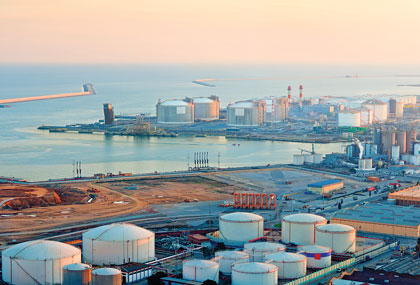Industry outlook
S. Potdar, AspenTech, Bedford, Massachusetts
Although LNG prices have hit a record low and capital costs of new production terminals continue to rise, a significant amount of pressure is on the industry to increase capacity by improving existing plant efficiencies and constructing more facilities.
The demand for LNG as an environmentally friendly energy source continues to grow in many regions. While a short period of oversupply is expected, the reality is that it will not last for long, as most construction projects underway will reach completion and be in production before the end of the decade. As a result, the industry will likely struggle to meet the need for additional supply capacity, and more liquefaction terminals (Fig. 1) will be needed in the coming years.
 |
|
Fig. 1. With advanced engineering software, existing and proposed LNG facilities |
Looking to 2021 and beyond, new LNG facilities would need to be in the planning stages or under development right now, as each project has a 5 yr–10 yr construction time line. While building new facilities seems like an obvious solution, many reasons exist why the industry—and investors, in particular—are hesitant to begin work on these projects.
In addition to the long time lines, the construction costs of LNG facilities have increased by 20%–30% since 2005, and 80% of today’s projects are over budget and behind schedule. While grassroots LNG terminals may seem like a risky investment, engineering design solutions are available to mitigate investment risk at a macro level, assist with optimizing design and reduce construction costs.
Utilizing advanced technology to plan ahead. Today’s LNG plant designers and operators are seeking new ways to improve efficiency and reduce operating costs (OPEX). The quickest and most effective way to reduce costs is to examine the liquefaction process for optimization opportunities. The liquefaction process, which accounts for 40% of OPEX, can be improved through an advanced process control (APC) solution, which helps increase yield and efficiency, bolster plant reliability and decrease costs.
Philip Oliver, CEO of ENGIE Global LNG, spoke at the 2015 Gastech Conference in Singapore, where he explained, “Oil will not stay at current lows, so we should avoid being hit by a double-whammy of rebounding oil prices and a growing shortage of LNG supply. New liquefaction and export projects need to be carefully advanced through the current down cycle, though many investors shy back from taking final investment decisions (FIDs) in the current low-price environment.”
With little time or resources to waste, a number of engineering, procurement and construction (EPC) firms are using leading-edge process plant design software to incorporate sophisticated capital cost-estimating solutions that allow organizations to reduce inefficient work processes. By implementing this type of advanced software, users can mitigate unproductive upfront design, avoid over-engineering (and over-spending) and better manage project execution. This software also allows companies to reduce capital costs and project blowouts and, ultimately, investor risk and uncertainty.
Optimizing models and testing scenarios. Economic strategists must examine key economic scenarios, such as future oil prices and demand, the impact of renewable energy sources, long-term contract viability in an over-supplied market and political stability at plant locations. It is imperative that LNG planning models review every conceivable scenario, including conceptual design, detailed design, project costs, anticipated throughput, planned efficiency, operations and maintenance, and return on investment (ROI). By ensuring that business scenarios are simulated and tested in advance, investors are provided with greater assurance.
Plant optimization software tools featuring a data historian and the ability to seamlessly interface multiple data formats have become readily available only recently. Modern process plant design software now incorporates the option to perform realistic and extensive technical simulations, which ensures that investment risks are mitigated and that worst- and best-case outcomes are considered for plant operations.
Moving toward a successful future. It is only a matter of time before demand outstrips supply, and low oil and LNG prices begin to increase. With design and construction development taking up to 10 yr, it is critical for new LNG projects to be on the top of project planning lists, if not already in the initial building phase.
Additionally, existing and proposed LNG facility owners should consider the benefits of leveraging the latest engineering software tools, as it will enable them to minimize risk and maximize ROI in a time of uncertainty. GP
 |
Sujit Potdar is AspenTech’s product manager for Aspen Exchanger Design and Rating. He has more than 10 years of experience in delivering software for engineering simulation.




Comments